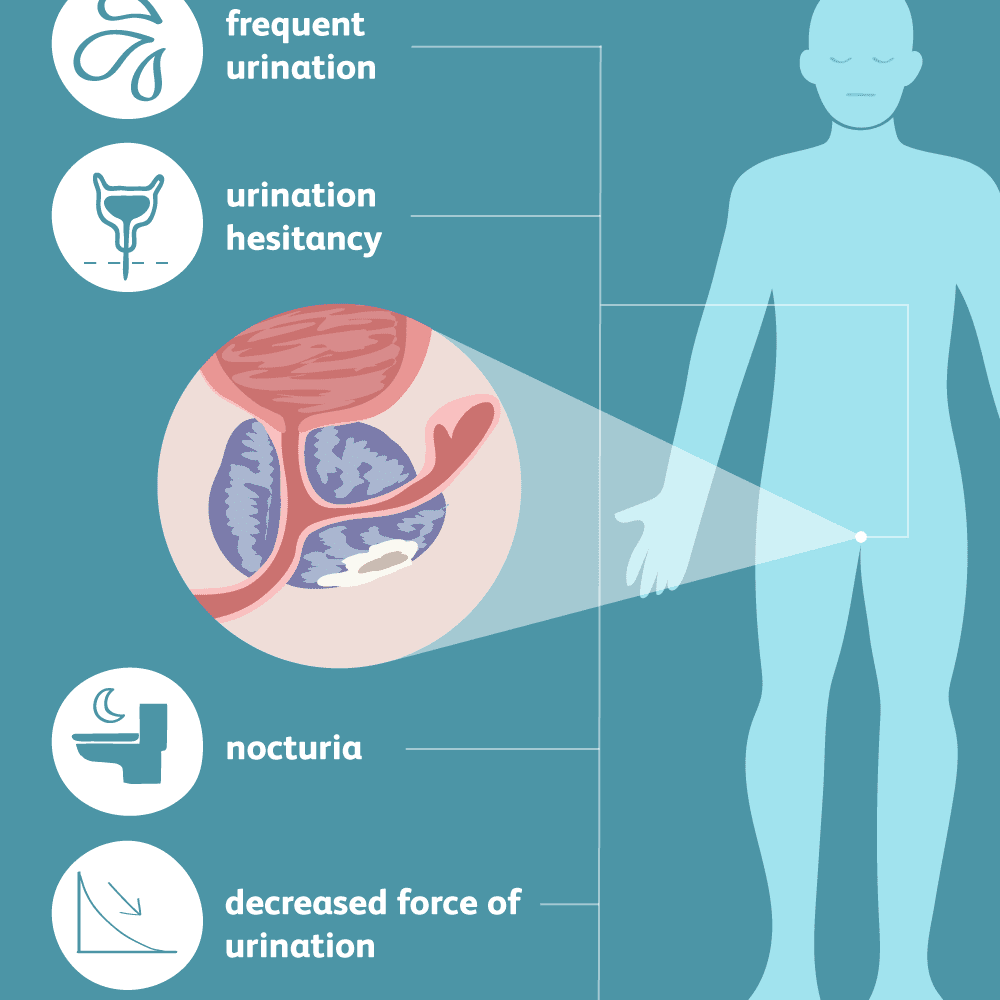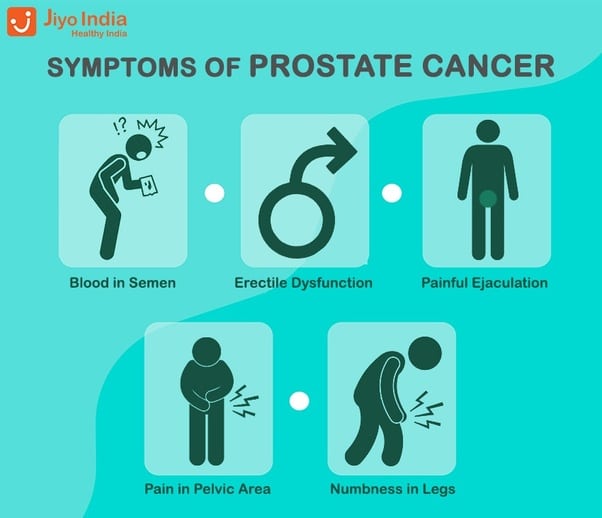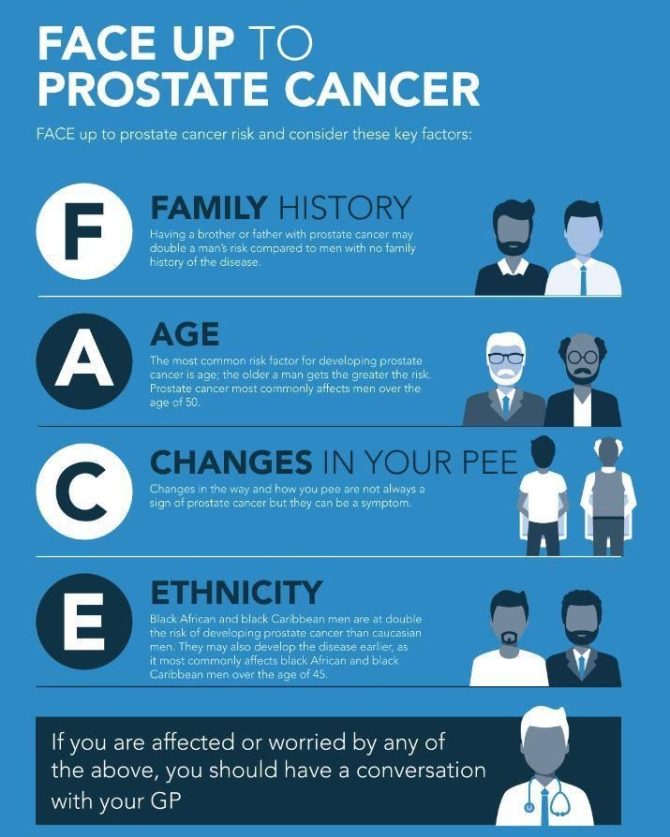How The Prostate Changes As You Age
Because the prostate gland tends to grow larger with age, it may squeeze the urethra and cause problems in passing urine. Sometimes men in their 30s and 40s may begin to have these urinary symptoms and need medical attention. For others, symptoms aren’t noticed until much later in life. An infection or a tumor can also make the prostate larger. Be sure to tell your doctor if you have any of the urinary symptoms listed below.
Tell your doctor if you have these urinary symptoms:
- Are passing urine more during the day
- Have an urgent need to pass urine
- Have less urine flow
- Feel burning when you pass urine
- Need to get up many times during the night to pass urine
Growing older raises your risk of prostate problems. The three most common prostate problems are inflammation , enlarged prostate , and prostate cancer.
One change does not lead to another. For example, having prostatitis or an enlarged prostate does not increase your risk of prostate cancer. It is also possible for you to have more than one condition at the same time.
What Causes Prostate Cancer
Researchers don’t know for sure what causes prostate cancer. They do know that it happens when there are changes in the genetic material .
Sometimes these genetic changes are inherited, meaning that you are born with them. There are also certain genetic changes that happen during your lifetime that can raise your risk of prostate cancer. But often the exact cause of these genetic changes is unknown.
The Grade Group And Psa Level Are Used To Stage Prostate Cancer
The stage of the cancer is based on the results of the staging and diagnostic tests, including the prostate-specific antigen test and the Grade Group. The tissue samples removed during the biopsy are used to find out the Gleason score. The Gleason score ranges from 2 to 10 and describes how different the cancer cells look from normal cells under a microscope and how likely it is that the tumor will spread. The lower the number, the more cancer cells look like normal cells and are likely to grow and spread slowly.
The Grade Group depends on the Gleason score. See the General Information section for more information about the Gleason score.
- Grade Group 1 is a Gleason score of 6 or less.
- Grade Group 2 or 3 is a Gleason score of 7.
- Grade Group 4 is a Gleason score 8.
- Grade Group 5 is a Gleason score of 9 or 10.
The PSA test measures the level of PSA in the blood. PSA is a substance made by the prostate that may be found in an increased amount in the blood of men who have prostate cancer.
You May Like: What Do Doctors Look For In A Prostate Exam
Does Prostate Cancer Have Any Symptoms
Most men with early prostate cancer dont have any signs or symptoms.
One reason for this is the way the cancer grows. Youll usually only get early symptoms if the cancer grows near the tube you urinate through and presses against it, changing the way you urinate . But because prostate cancer usually starts to grow in a different part of the prostate, early prostate cancer doesnt often press on the urethra and cause symptoms.
If you do notice changes in the way you urinate, this is more likely to be a sign of a very common non-cancerous problem called an enlarged prostate, or another health problem. But its still a good idea to get it checked out. Possible changes include:
- difficulty starting to urinate or emptying your bladder
- a weak flow when you urinate
- a feeling that your bladder hasnt emptied properly
- dribbling urine after you finish urinating
- needing to urinate more often than usual, especially at night
- a sudden need to urinate you may sometimes leak urine before you get to the toilet.
If prostate cancer breaks out of the prostate or spreads to other parts of the body , it can cause other symptoms, including:
- back pain, hip pain or pelvis pain
- problems getting or keeping an erection
- unexplained weight loss.
These symptoms can all be caused by other health problems. But its still a good idea to tell your GP about any symptoms so they can find out whats causing them and make sure you get the right treatment, if you need it.
What Is The Treatment For Advanced Prostate Cancer

No matter where prostate cancer spreads, its still treated as prostate cancer. Its harder to treat when it reaches an advanced stage.
Treatment for advanced prostate cancer involves targeted and systemic therapies. Most men need a combination of treatments and they may have to be adjusted from time to time.
Also Check: How To Shrink Prostate Mayo Clinic
Genetic Testing For Prostate Cancer
You may hear a lot about genetics or genomics. Both terms are related to genes and cell DNA, but they are different. These tests are being used to learn more about the DNA of cancer cells, and link DNA mutations with treatments. In the future, genetic testing may be the first step doctors take when diagnosing prostate cancer.
Should I Have A Psa Test
Because the results of the PSA test are not as reliable as doctors would like, other tests and investigations are needed to diagnose prostate cancer.
A PSA test cannot identify prostate cancer on its own, and changes in PSA levels alone are not a good reason to start treatment.
If you are thinking about asking for a PSA test, it is important that you first discuss whether it is right for you with your GP so you understand what the results might mean.
The Prostate Cancer Risk Management Programme has information on the risks and benefits of the PSA test to help you decide whether or not to have it.
Don’t Miss: Metastatic Castration Resistant Prostate Cancer Mcrpc
What Are The Risk Factors For Prostate Cancer
Some of the greatest risk factors for prostate cancer include:
- Age. Prostate cancer is very rare in men younger than 40 years of age. In contrast, approximately 60% of prostate cancer cases occur in men that are older than 65.
- Race. African-American men tend to be at greater risk for prostate cancer compared to non-Hispanic whites, whereas Asian-Americans and Hispanic/Latino men are less susceptible to this disease.
- Location. Prostate cancer is most common in North America, Europe, Australia, and the Caribbean. It is rarer in Asia, Africa, and Central and South America. This may be because of more intensive screening procedures for the disease in certain countries, although lifestyle factors such as diet could also play a key role in the difference.
- Family history. In many cases, there is a strong hereditary factor associated with the emergence of prostate cancer. In fact, men who have a father or brother with prostate cancer have a much higher risk of developing it themselves.
Other possible risk factors could include a dairy-rich diet, obesity, smoking, and exposure to harmful chemicals.
Symptoms Of Prostate Cancer
Though early warning signs of prostate cancer are rare, sometimes men experience symptoms before they are diagnosed. The severity of symptoms may depend on where the cancer is located in the prostate and how advanced it has become. However, having any of these symptoms does not necessarily mean that you have prostate cancer or that the disease has progressed beyond its early stages.
Don’t Miss: Is A Hard Prostate Always Cancer
How Is Prostate Cancer Diagnosed
Screenings are the most effective way to catch prostate cancer early. If you are at average cancer risk, youll probably have your first prostate screening at age 55. Your healthcare provider may start testing earlier if you have a family history of the disease or are Black. Screening is generally stopped after age 70, but may be continued in certain circumstances.
Screening tests for prostate cancer include:
- Digital rectal exam: Your provider inserts a gloved, lubricated finger into the rectum and feels the prostate gland, which sits in front of the rectum. Bumps or hard areas could indicate cancer.
- Prostate-specific antigen blood test: The prostate gland makes a protein called protein-specific antigen . Elevated PSA levels may indicate cancer. Levels also rise if you have BPH or prostatitis.
- Biopsy: A needle biopsy to sample tissue for cancer cells is the only sure way to diagnose prostate cancer. During an MRI-guided prostate biopsy, magnetic resonance imaging technology provides detailed images of the prostate.
What Should I Do If I Have Prostate Cancer Symptoms
If you are displaying one or more signs of prostate cancer, be sure to promptly consult with a physician. Even benign prostate conditions like prostate enlargement warrant timely medical attention, so dont delay seeking treatment. And, like most other malignancies, prostate cancer is usually more easily treated when it is detected at an early stage.
Medically reviewed by Monica Chatwal, MD.
At Moffitt Cancer Center, we provide a full range of diagnostic testing for prostate cancer. If you have received a prostate cancer diagnosis, we understand that every day counts, and we want to support you every step of the way. Our Urologic Oncology Program includes a multispecialty team that focuses exclusively on evaluating and treating prostate cancer.
Contact Moffitt at or complete a new patient registration form online to speak with one of our specialized oncologists about your symptoms. As Floridas top cancer hospital, were committed to providing all new patients rapid access to a cancer expert within a day of their reaching out.
Don’t Miss: Folic Acid And Prostate Cancer
Symptoms Of Prostate Cancer Spread To The Bones
The most common place for prostate cancer to spread to is the bones. This can include the:
The most common symptom if cancer has spread to the bone is bone pain. It is usually there most of the time and can wake you up at night. The pain can be a dull ache or stabbing pain.
Your bones might also become weaker and more likely to break .
When prostate cancer spreads to the spine, it can put pressure on the spinal cord and cause spinal cord compression. This stops the nerves from being able to work properly. Back pain is usually the first symptom of spinal cord compression.
Spinal cord compression is an emergency. You should contact your treatment team immediately if you are worried you might have spinal cord compression.
Bph And Other Conditions

There are other conditions that affect the prostate that can have similar symptoms as prostate cancer. Those conditions include benign prostatic hyperplasia and prostatitis. BPH is a noncancerous enlargement of the prostate gland caused by aging, testosterone and genetics.
BPH is not cancer but has similar symptoms.
Another condition is prostatitis, an inflammation of the prostate gland that occurs from bacterial infection. Roughly half of all men will be affected by prostatitis during their lives.
Also Check: Prostate Cancer Robotic Surgery Recovery
Talking With Your Doctor
Different kinds of doctors and other health care professionals manage prostate health. They can help you find the best care, answer your questions, and address your concerns. These health care professionals include:
- Family doctors and internists
- Physician assistants and nurse practitioners
- Urologists, who are experts in diseases of the urinary tract system and the male reproductive system
- Urologic oncologists, who are experts in treating cancers of the urinary system and the male reproductive system
- Radiation oncologists, who use radiation therapy to treat cancer
- Medical oncologists, who treat cancer with medications such as hormone treatments and chemotherapy
- Pathologists, who identify diseases by studying cells and tissues under a microscope
View these professionals as your partnersâexpert advisors and helpers in your health care. Talking openly with your doctors can help you learn more about your prostate changes and the tests to expect.
Risk Factors For Prostate Cancer
Some risk factors have been linked to prostate cancer. A risk factor is something that can raise your chance of developing a disease. Having one or more risk factors doesn’t mean that you will get prostate cancer. It just means that your risk of the disease is greater.
- Age. Men who are 50 or older have a higher risk of prostate cancer.
- Race. African-American men have the highest risk of prostate cancerâthe disease tends to start at younger ages and grows faster than in men of other races. After African-American men, prostate cancer is most common among white men, followed by Hispanic and Native American men. Asian-American men have the lowest rates of prostate cancer.
- Family history. Men whose fathers or brothers have had prostate cancer have a 2 to 3 times higher risk of prostate cancer than men who do not have a family history of the disease. A man who has 3 immediate family members with prostate cancer has about 10 times the risk of a man who does not have a family history of prostate cancer. The younger a man’s relatives are when they have prostate cancer, the greater his risk for developing the disease. Prostate cancer risk also appears to be slightly higher for men from families with a history of breast cancer.
- Diet. The risk of prostate cancer may be higher for men who eat high-fat diets.
Read Also: Late Stage Prostate Cancer Treatment
Screening For Prostate Cancer
There are no tests available with sufficient accuracy to screen populations of men for early signs of prostate cancer. However, early detection and treatment can significantly improve prostate cancer survival.
The test most commonly used to aid early detection of prostate cancer is the prostate specific antigen blood test. This is not a diagnostic test as it can only indicate changes in the prostate. If you are concerned about prostate cancer you should talk to your doctor and make an informed choice about whether to have one of the tests designed to find early signs of prostate cancer, in view of the potential risks and benefits.
There are no proven measures to prevent prostate cancer.
The Top 7 Signs Of Advanced Prostate Cancer
In the early stages, you may not notice any symptoms related to prostate cancer. This is why screenings are important. Symptoms can sometimes be noticed for the first time when the cancer advances.
Advanced prostate cancer, also called metastatic cancer, means the cancer has spread to other areas of your body beyond your prostate gland. The most common areas for prostate cancer to spread are your bladder, rectum, and bones. It can also spread to your lymph nodes, liver, lungs, and other body tissues.
Whether youve just been diagnosed or youre in treatment, its also important to know the signs of advanced cancer. Cancer can behave differently depending on your genetics, so not every person will experience the same symptoms in the same way.
Read on to learn more about the seven top symptoms of advanced prostate cancer and how to spot them.
Recommended Reading: What Age To Start Prostate Screening
Cancer May Spread From Where It Began To Other Parts Of The Body
When cancer spreads to another part of the body, it is called metastasis. Cancer cells break away from where they began and travel through the lymph system or blood.
- Lymph system. The cancer gets into the lymph system, travels through the lymph vessels, and forms a tumor in another part of the body.
- Blood. The cancer gets into the blood, travels through the blood vessels, and forms a tumor in another part of the body.
The metastatic tumor is the same type of cancer as the primary tumor. For example, if prostate cancer spreads to the bone, the cancer cells in the bone are actually prostate cancer cells. The disease is metastatic prostate cancer, not bone cancer.
Denosumab, a monoclonal antibody, may be used to preventbone metastases.
Advanced Prostate Cancer Symptoms
Men with advanced prostate cancer may experience additional symptoms. Thats because the cancer has spread from the prostate to other parts of the body, such as the bones or lymph nodes.
Signs of metastatic prostate cancer may include:
- Swelling in legs or pelvic area
- Numbness or pain in the hips, legs or feet
- Bone pain that persists or leads to fractures
A wide range of treatment options are available for managing advanced cancer. These treatments kill cancer cells, but they may also help patients manage pain.
Prostate cancer treatment: The care you need is one call away
Your multidisciplinary team will work with you to develop a personalized plan to treat your prostate cancer in a way that fits your individual needs and goals.
Read Also: Can You Have An Erection Without Prostate
Who Is More Likely To Develop Prostate Cancer
Anyone who has a prostate can develop prostate cancer. But certain factors can make you more likely to develop it:
- Age. Your chance of developing prostate cancer increases as you get older. Prostate cancer is rare in people under age 50.
- Family health history. Your risk of prostate cancer is higher if you have a parent, sibling, or child who has or has had prostate cancer.
- Race. African Americans are more likely to get prostate cancer. They’re also more likely to:
- Get prostate cancer at a younger age.
- Have more serious prostate cancer.
- Die from prostate cancer.
Prostate Cancer Caregiver Podcast Series

We are proud to announce a new podcast series geared toward helping give support, hope and guidance to prostate cancer caregivers. The goal of this Prostate Cancer Caregiver Podcast Series is to help others connect with a diverse group of people who have felt the impact of prostate cancer in their lives and empower them on their journey.
Don’t Miss: How Far In Is Your Prostate
